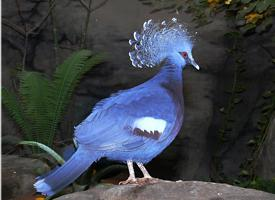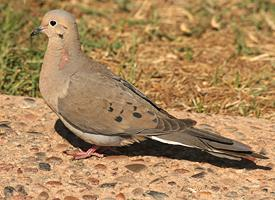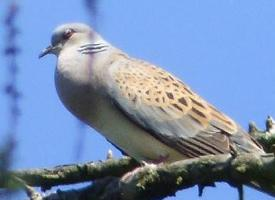
Súlyok és méretek
| Hossz | 31-tól 33-ig cm |
|---|---|
| Súly | 150-tól 200-ig g |
| Szárnyfesztávolság | 47-tól 55-ig cm |
Veszélyeztetettség
| Rettenthetetlen |
Állatleírás
The Eurasian collared dove, scientifically known as Streptopelia decaocto, is a bird species that has captured the attention of birdwatchers and nature enthusiasts alike with its distinctive appearance and melodious cooing. Native to parts of Europe and Asia, this bird has shown remarkable adaptability, expanding its range dramatically over the past century to include much of North America.Characterized by its medium size, the Eurasian collared dove measures approximately 32 to 34 centimeters in length and boasts a wingspan of 47 to 55 centimeters. Its plumage is primarily a soft, light grey color, with darker feathers on the wings and back that provide a gentle contrast. The bird's name derives from a distinctive black half-collar at the nape of the neck, a feature that is both elegant and easily identifiable. The eyes are dark with a slight reddish hue, surrounded by a narrow area of bare skin that gives them a striking appearance. The beak is slender and black, while the legs and feet exhibit a reddish hue, completing the bird's subtle yet appealing color palette.
Eurasian collared doves exhibit a remarkable versatility in habitat preference, thriving in both urban and rural settings. They are commonly found in farmlands, suburban gardens, parks, and woodland edges, demonstrating a preference for areas in close proximity to human habitation where food and nesting sites are readily available. This adaptability has been a key factor in their successful colonization of new territories.
Dietarily, these doves are granivorous, feeding primarily on seeds from a variety of grasses, grains, and occasionally from bird feeders in gardens. Their feeding habits have them often foraging on the ground, where they walk with a graceful, deliberate stride, pecking at food items as they go.
The call of the Eurasian collared dove is a distinctive, three-syllable cooing, often phonetically represented as "coo-COO-coo". This sound is a familiar backdrop in areas where these birds are prevalent, contributing to the ambient soundscape of early mornings and late afternoons. Males often perform this call from a high perch to attract a mate or assert their territory.
Breeding season sees these doves exhibit a strong monogamous bond, with pairs often remaining together for life. They are prolific breeders, capable of raising several broods of two eggs each year. Their nests are relatively simple structures, built from twigs and located in trees, on building ledges, or in other sheltered areas. Both parents share in the duties of incubating the eggs and feeding the young, showcasing a remarkable level of parental care.
The expansion of the Eurasian collared dove's range is a testament to its adaptability and resilience. Initially found primarily in parts of Asia and the Balkans, the species began expanding westward in Europe during the 20th century, reaching the British Isles in the 1950s. Its arrival in North America in the 1970s, via the Bahamas, marked the beginning of a rapid expansion across the continent, demonstrating the species' remarkable ability to thrive in new environments.
Despite its success in colonizing new territories, the Eurasian collared dove is not considered invasive in most of its range, as it typically does not have a significant negative impact on native species or human activities. Instead, it has become a welcomed addition to the biodiversity of many areas, adding beauty and a serene soundtrack to the environments it inhabits.
In summary, the Eurasian collared dove is a fascinating and adaptable bird species, with a gentle demeanor and a capacity for thriving in close proximity to humans. Its widespread presence across continents is a remarkable story of natural expansion, making it a subject of interest for conservationists, researchers, and bird enthusiasts around the world.
Hasonló állatok
Új állatfotók
Top 10 állat
- Dolphin gull (Leucophaeus scoresbii)
- Japanese macaque (Macaca fuscata)
- Stone loach (Barbatula barbatula)
- Galápagos tortoise (Geochelone nigra complex)
- Russian tortoise (Testudo horsfieldii)
- Greek tortoise (Testudo graeca)
- Diana monkey (Cercopithecus diana)
- Common flying dragon (Draco volans)
- Moustached guenon (Cercopithecus cephus)
- Galápagos penguin (Spheniscus mendiculus)


